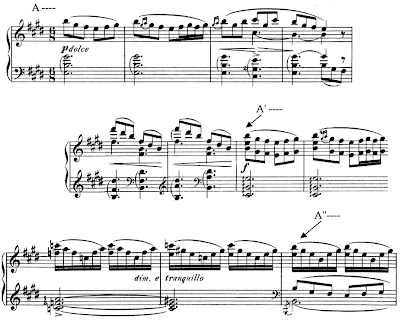The task is to describe different visual tracks as they relate to a single audio track. I chose performances of a musical composition because they're easy to find on YouTube and often are relatively stable there (that is, not taken down), but more so because the limits of the musical text allow us to treat the sound track more or less as a control, against which we can more easily compare different collections of images, still and moving. Tempo remains a variable in the audio track as well, of course, but we will minimize that by looking first at three visualizations of the same recorded musical performance.
The composition is "Morgenstimmung" (Morning Mood), the first movement in Edvard Grieg's Peer Gynt Suite No. 1, Op. 46. The design is simple: A - A' (expanded) - A'' (as coda or ending section). Here are the corresponding moments in musical notation (piano reduction only).

Timings for the three sections in the performance by the Berlin Philharmonic under Herbert von Karajan are included at the top of the next example, which charts the principal harmonic changes through the movement. (The image is a thumbnail -- click on it to see the original.)

Version no. 1: link. [Link is broken; checked on 3-08-2024.] One might think of this as a "control" since the image track is static, nothing but a title card. In fact, however, this is in some ways the most difficult version to study because the students must be able to pay attention to their attention, so to speak. Once they guess that the image is probably not going to change, attention shifts away from it to the music, in a radical version of what Claudia Gorbman calls the "pure cultural musical code," that is, music as performance. A clever student who refuses the let the image track go entirely may relate the starkness of the black background to the audiovisual sparseness of a video that is only music.
Version no. 2: link. [Link is broken; checked on 3-08-2024.] The same recording (played twice!) with a slide show of images. Questions to consider: how are changes to a new image timed to the music track? (Generally, they avoid synchronization -- images change shortly before the downbeat of a new bar. Exceptions @ about 2:40.) What is the effect of the lack of synchronization @ important form articulations in the music? (If images had changed at those moments, the images would suddenly have seemed relatively "important", leading to speculation about reasons for that importance. Something similar happens in a couple cases where the slide is onscreen noticeably longer than the others.) What kind of narrative content (or expectation for narrative continuity) is provoked by the slide show? (The obvious one would be the minimal narrative of dawn in many different locales -- but here again there are a few exceptions, slides that obviously depict mid-day. One might also ask whether chronological continuity is important -- one slide of a darkened tree and a pre-dawn planet seems out of place. In the case of narrative, it is not important to come up with answers -- what is important is to notice the fact of imposing (or trying to impose) narrative continuity on the images.) The ending of the first playthrough is obviously clumsy in the image track (the photo of Grieg appears twice in short order and then the slide show starts up a third time a few seconds before the piece ends).
Version 3: link. [Link checked on 3-08-2024.]An upgrade to the slide show that makes a very good comparison for no. 2. Here the poster is playing with simple effects applied to a video of a fire in a fireplace. Because the editing is plainly done by someone (no. 2's slide show could have been an app on autopilot), the questions of intention and design arise more seriously. (If students know about it, a discussion of the associations brought up by the context of the YouTube "Kaminfeuer" trope could be interesting -- here again, it's not the information that is important but the realization of the power of these external associations to shape or guide the viewing -- very much like genre expectations in feature films.)
Version no. 4: link. [Link checked on 3-08-2024.]Not Karajan. By comparison with no. 2, both performance and slide show seem frenetic.
Version no. 5: link. [Link is broken; checked on 3-08-2024.] Here is what Gorbman really meant by the "pure" code in feature films: a filmed performance of the piece by an orchestra. The camera is static. Compare to this performance that has multiple cameras and was edited: link.
